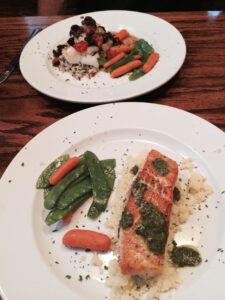My clients often ask me: “How do I get more protein in my diet? I eat plenty of carbohydrates but always fall short on my daily protein intake.” Some experts believe that it is not necessary to eat protein with each meal. As a PN certified nutrition coach, I trust that a diet higher in protein is safe and effective. Eating complete proteins with each meal not only lowers your body fat and increases your muscle mass but also stimulates your metabolism.
What Is A Protein?
Protein is a large and complex molecule consisting of amino acids (which contain nitrogen) that are essential for living cells.
What is the energy value of protein:
1 gram of protein = 5.65 calories or kcal
Compare that to:
1 gram of carbohydrates = 4 calories
1 gram of alcohol = 7 calories
1 gram of fat = 9 calories
The body has the ability to make 12 amino acids on its own, they are known as non-essential amino acids. 8 amino acids can only be supplied through your diet and must be replenished daily.
Animal protein ranks the highest in protein measures, while plant-based protein ranks the lowest. It is commonly believed that plants don’t contain amino acids and, therefore, are not a good source of protein. That is really not the case. (Source: PN Nutrition, The Essentials of Sport and Exercise Nutrition, second edition)
For those following a plant-based diet, protein intake should be adequate by following the guidelines below:
- Eat enough to sustain a lean body
- Don’t build a diet around processed foods
- Eat a diet diverse in plant foods, for instance, vegetables, beans, nuts, seeds
- Eat at least ¼ cup – 1 cup of beans/legumes each day
How much protein should you eat at each meal?
At PN Nutrition, we recommend 20-30g of lean, complete protein for women and 40-60g for men at each meal.
Here are some meat, vegetarian, and vegan sources of protein:
- Lean red meat
- Salmon
- Lean chicken
- Eggs and egg whites
- Cheese
- Low-fat plain Greek yogurt, cottage cheese, and milk
- Soy and Almond milk
- Peanut or Almond butter
- Protein Supplements (whey, milk, soy, pea, hemp protein source)
- Chia seed and flaxseed; add them to smoothies and breakfast cereals
- Quinoa, amaranth, buckwheat
- Pistachios, cashews, walnuts, almonds, pumpkin seeds
- Tofu, Tempeh, Natto and Miso
- Lentils, black beans, pinto beans, chickpeas, split peas, hummus
All it takes is some planning while shopping for protein. Set aside a little prep time on the weekends to have a pantry/fridge full of protein sources.

Here are other delicious breakfast, lunch, and dinner ideas:
- Seared Yellowfin Tuna steak on a bed of spring salad with sesame ginger dressing, Pecans, and Strawberries
- Minestrone soup
- Whole-grain slice of bread, banana french toast, sprinkle with almonds
- Steamed Brussels sprouts, leg of lamb with parsley, onion, and garlic
- Asian meatballs with apple, avocado, mushrooms, and almonds
Now it’s your turn. Find some delicious recipes or create your own based on the list of proteins above.